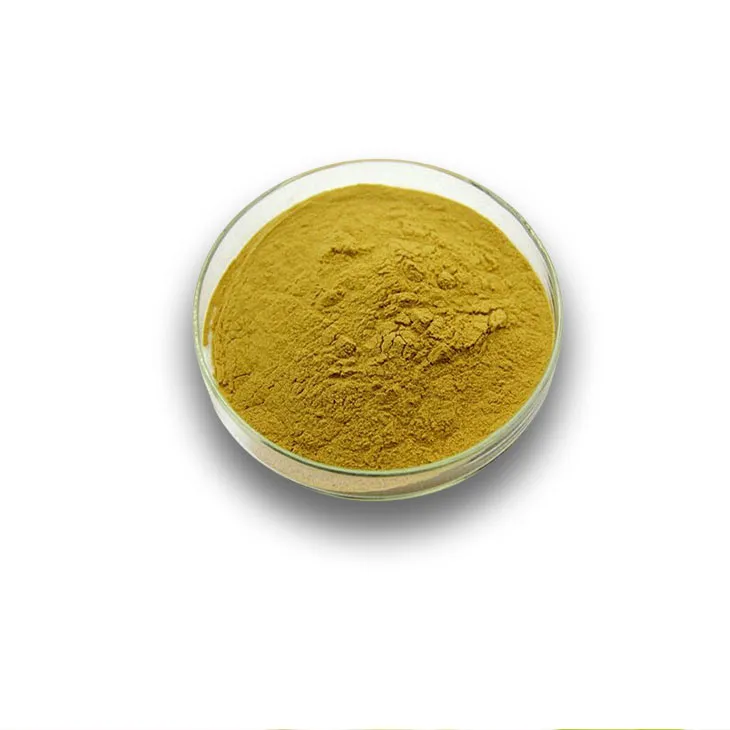- 0086-571-85302990
- sales@greenskybio.com
The process of extracting chlorogenic acid from honeysuckle pollen.
2024-11-29

1. Introduction
Chlorogenic acid, a significant bioactive compound, has drawn extensive attention in recent years. Honeysuckle pollen, as a potential rich source of chlorogenic acid, holds great promise for extraction. The extraction of chlorogenic acid from Honeysuckle Pollen is a complex yet potentially rewarding process. This article aims to comprehensively explore this process from multiple aspects.

2. The Importance of Chlorogenic Acid
2.1 In the Field of Medicine
Chlorogenic acid has demonstrated various pharmacological activities. It exhibits antioxidant properties, which can help in combating oxidative stress in the body. Oxidative stress is associated with a wide range of diseases such as cancer, cardiovascular diseases, and neurodegenerative disorders. By scavenging free radicals, chlorogenic acid can potentially reduce the risk of these diseases.
Moreover, it has anti - inflammatory effects. Inflammatory responses are a part of the body's defense mechanism, but chronic inflammation can lead to tissue damage and various diseases. Chlorogenic acid can modulate the inflammatory pathways, reducing the production of pro - inflammatory cytokines and mediators.
2.2 In the Food and Beverage Industry
Chlorogenic acid is also of great importance in the food and beverage industry. It can act as a natural preservative due to its antioxidant properties. In coffee, for example, chlorogenic acid is one of the major components contributing to its antioxidant capacity. It can also enhance the flavor and aroma of certain foods and beverages.
Furthermore, with the increasing demand for healthy and functional foods, chlorogenic acid - rich products are becoming more popular. It can be added to various products such as dietary supplements, energy drinks, and functional foods to provide health - promoting benefits.

3. Extraction Technologies
3.1 Solvent Extraction
Solvent extraction is one of the most commonly used methods for extracting chlorogenic acid from honeysuckle pollen. Ethanol and methanol are often used as solvents.
Advantages:
- It is relatively simple and cost - effective.
- High solubility of chlorogenic acid in these solvents allows for a relatively high extraction yield.
- The use of organic solvents may pose environmental and safety concerns.
- There may be co - extraction of other impurities along with chlorogenic acid, which requires further purification steps.
3.2 Supercritical Fluid Extraction (SFE)
Supercritical fluid extraction utilizes supercritical carbon dioxide as the extraction medium. The supercritical state of carbon dioxide has unique properties, such as high diffusivity and low viscosity.
Advantages:
- It is a clean and green extraction method as carbon dioxide is non - toxic, non - flammable, and environmentally friendly.
- It can selectively extract chlorogenic acid with high purity, reducing the need for extensive purification.
- The equipment for supercritical fluid extraction is relatively expensive, which may limit its widespread application.
- It requires precise control of extraction conditions such as pressure and temperature.
3.3 Microwave - Assisted Extraction (MAE)
Microwave - assisted extraction uses microwave energy to enhance the extraction process. Microwaves can penetrate the sample and cause rapid heating, which can increase the extraction efficiency.
Advantages:
- It significantly reduces the extraction time compared to traditional extraction methods.
- The extraction yield of chlorogenic acid can be relatively high.
- There may be non - uniform heating, which can lead to the degradation of chlorogenic acid in some parts of the sample.
- The equipment also requires a certain level of investment and maintenance.

4. The Impact of Pretreatment of Honeysuckle Pollen on Extraction Results
Pretreatment of Honeysuckle Pollen is a crucial step that can significantly affect the extraction results of chlorogenic acid.
4.1 Drying
Drying the honeysuckle pollen before extraction is a common pretreatment method. Different drying methods such as air drying, oven drying, and freeze - drying can have different impacts.
Air drying is a simple and low - cost method, but it may take a relatively long time, and there may be some losses of chlorogenic acid during the long - term drying process. Oven drying can control the drying temperature and time more precisely, but if the temperature is too high, it may cause the degradation of chlorogenic acid. Freeze - drying can better preserve the structure and bioactive components of the pollen, but it is more expensive.
4.2 Grinding
Grinding the honeysuckle pollen into a fine powder can increase the surface area of the sample, which is beneficial for the extraction of chlorogenic acid. However, over - grinding may cause the destruction of the cell structure and the release of some interfering substances, which may affect the extraction purity.

5. Future Prospects
5.1 Improving Extraction Efficiency
To improve the extraction efficiency of chlorogenic acid from honeysuckle pollen, further research is needed. Combining different extraction methods may be a promising approach. For example, using microwave - assisted solvent extraction can combine the advantages of both microwave - assisted extraction and solvent extraction, potentially achieving higher extraction yields in a shorter time.
Optimizing the extraction conditions such as solvent concentration, extraction time, temperature, and pressure can also play a crucial role in improving the extraction efficiency. Advanced technologies such as artificial intelligence and machine learning can be used to predict the optimal extraction conditions based on the characteristics of honeysuckle pollen and the properties of chlorogenic acid.
5.2 Expanding Application Areas
As the understanding of the health benefits of chlorogenic acid continues to increase, the application areas of chlorogenic acid extracted from honeysuckle pollen are expected to expand.
In the cosmetic industry, chlorogenic acid can be used in anti - aging and skin - whitening products due to its antioxidant and anti - inflammatory properties. In the agricultural field, it may have potential applications in plant growth promotion and disease resistance. Additionally, with the development of nanotechnology, chlorogenic acid - loaded nanoparticles may be developed for targeted drug delivery and other biomedical applications.
6. Conclusion
The extraction of chlorogenic acid from honeysuckle pollen is a multi - faceted process that involves various aspects such as extraction technologies, pretreatment of raw materials, and future prospects. Understanding the importance of chlorogenic acid in different fields provides the motivation for further research and development. By continuously exploring and optimizing the extraction process, it is possible to improve the extraction efficiency and expand the application areas of chlorogenic acid from honeysuckle pollen, bringing more benefits to various industries and human health.
FAQ:
1. What is the significance of chlorogenic acid in different fields?
Chlorogenic acid has multiple important roles in various fields. In the medical field, it shows antioxidant, anti - inflammatory, and antibacterial properties. It can help in preventing certain diseases and promoting health. In the food industry, it can be used as a natural preservative due to its antioxidant properties. Also, in the cosmetic field, it is beneficial for skin health, such as anti - aging and anti - acne effects.
2. What are the common extraction technologies for chlorogenic acid from honeysuckle pollen?
There are several common extraction technologies. One is the solvent extraction method, which uses solvents like ethanol or methanol to extract chlorogenic acid. Another is the supercritical fluid extraction, which has the advantage of being more environmentally friendly and can obtain high - purity products. There is also the microwave - assisted extraction method, which can speed up the extraction process.
3. What are the advantages and disadvantages of different extraction technologies?
For solvent extraction, the advantage is that it is a relatively simple and traditional method with relatively low cost. However, the disadvantage is that it may use large amounts of solvents, and there may be solvent residues. Supercritical fluid extraction has the advantage of high efficiency, selectivity, and no solvent residue, but the equipment is expensive. Microwave - assisted extraction can save time, but it may not be suitable for large - scale production and may cause some degradation of the target compound.
4. How does the pre - treatment of honeysuckle pollen affect the extraction results?
The pre - treatment of honeysuckle pollen can have a significant impact on the extraction results. For example, proper drying can help preserve the content of chlorogenic acid in the pollen. Grinding the pollen into a fine powder can increase the surface area, which is beneficial for the solvent to contact the chlorogenic acid, thereby improving the extraction efficiency. However, improper pre - treatment may lead to the loss of chlorogenic acid or the introduction of impurities.
5. What are the future prospects for improving the extraction efficiency of chlorogenic acid from honeysuckle pollen?
The future prospects for improving the extraction efficiency are promising. Research may focus on developing new extraction technologies or optimizing existing ones. For example, combining different extraction methods to take advantage of their respective strengths. Also, genetic engineering may be used to modify honeysuckle plants to increase the content of chlorogenic acid in the pollen, which can ultimately improve the extraction efficiency.
6. What are the potential application areas of chlorogenic acid from honeysuckle pollen in the future?
In the future, in addition to the existing application areas in medicine, food, and cosmetics, chlorogenic acid from honeysuckle pollen may be applied in new areas. For example, in the field of functional foods for specific health - promoting functions. It may also be used in the development of new drugs for treating more complex diseases. Moreover, in the environmental protection field, it may have potential applications due to its antioxidant and antibacterial properties.
Related literature
- Chlorogenic Acid: A Review on Its Isolation, Purification and Antioxidant Properties"
- "The Extraction and Application of Chlorogenic Acid from Honeysuckle: A Comprehensive Study"
- "Advances in the Pre - treatment of Honeysuckle Pollen for Chlorogenic Acid Extraction"
- ▶ Hesperidin
- ▶ citrus bioflavonoids
- ▶ plant extract
- ▶ lycopene
- ▶ Diosmin
- ▶ Grape seed extract
- ▶ Sea buckthorn Juice Powder
- ▶ Beetroot powder
- ▶ Hops Extract
- ▶ Artichoke Extract
- ▶ Reishi mushroom extract
- ▶ Astaxanthin
- ▶ Green Tea Extract
- ▶ Curcumin Extract
- ▶ Horse Chestnut Extract
- ▶ Other Problems
- ▶ Boswellia Serrata Extract
- ▶ Resveratrol Extract
- ▶ Marigold Extract
- ▶ Grape Leaf Extract
- ▶ blog3
- ▶ blog4
-
Wholesale Mulberry Leaf Extract Suppliers.
2024-11-29
-
China Aguaje Extract Powder Factory.
2024-11-29
-
Mulberry Extract Suppliers.
2024-11-29
-
Active components in aguaje extract.
2024-11-29
-
Standard - process cocoa extract.
2024-11-29
-
Organic Saw Palmetto Extract Powder Factory.
2024-11-29
-
Suppliers of Organic Açai Extract Powder.
2024-11-29
-
Extraction process of black pepper extract.
2024-11-29
-
Wholesale L - Tyrosine Suppliers.
2024-11-29
-
Mulberry Extract
2024-11-29
-
Giant Knotweed Extract
2024-11-29
-
Panax Ginseng Leaf Extract
2024-11-29
-
Hawthorn Extract
2024-11-29
-
Plantain extract
2024-11-29
-
Milk Thistle Extract
2024-11-29
-
Bamboo Leaf extract
2024-11-29
-
Avocado Extract Powder
2024-11-29
-
Pine bark Extract Powder
2024-11-29
-
Kelp Extract Powder
2024-11-29





















